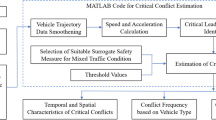Abstract
Intersections are road traffic accident-prone locations. About 10–40% of the traffic accidents take place at intersections worldwide every year. An intersection in Haidian District, Bei**g was surveyed by video survey method, and the survey videos were processed and analyzed. The velocities and trajectories of the vehicles at the intersection were collected. Analysis of the homogeneity of driver behaviors shows that vehicles have the best homogeneity of velocities when passing the stop line and the crosswalk. Right-turning vehicles have the best homogeneity of velocities, left-turning vehicles take the second place, and homogeneity of velocities of straight-going vehicles is the worst. Straight-going vehicles have the best homogeneity of trajectories, right-turning vehicles take the second place, and left-turning vehicles have the worst homogeneity of trajectories. The results provide references for driver behavior modeling at intersections and the development of intersection driving assistant systems.
Access this chapter
Tax calculation will be finalised at checkout
Purchases are for personal use only
Similar content being viewed by others
References
Zou, H.B., and J.M. Xu. 2008. Application of traffic conflict technology in assessing the intersection safety in Guilin. Western China Communications Science & Technology 1: 20–22.
Wang, W.H., H.W. Guo, and W.W. Guo. 2013. Transportation behavior analysis and traffic safety evaluation, 54–55. Bei**g: Bei**g Institute of Technology Press.
Zhang, L., X.W. Huang, and W.M. Wu. 2014. The analysis of driver’s behavior in non-signalized intersection based on the game. Applied Mechanics and Materials 505–506: 1157–1162.
**, J., W. Wang, G. Wets, et al. 2014. Effect of restricted sight on right-turn driver behavior with pedestrians at signalized intersection. Advances in Mechanical Engineering 2014 (1): 1–6.
Werneke, J., and M. Vollrath. 2014. How do environmental characteristics at intersections change in their relevance for drivers before entering an intersection: analysis of drivers’ gaze and driving behavior in a driving simulator study. Cognition, Technology & Work 16 (2): 157–169.
Rittger, L., G. Schmidt, C. Maag, et al. 2015. Driving behaviour at traffic light intersections. Cognition, Technology & Work 17 (4): 1–13.
Danaf, M., S. H. Hamdar, M. Abouzeid, et al. 2016. Comparative assessment of driving behavior at signalized intersections using driving simulators. Journal of Transportation Safety & Security 1–35.
Theeuwes, J., and H. Godthelp. 1995. Self-explaining roads. Safety Science 19 (2–3): 217–225.
Van Vliet, P., and G. Schermers. 2000. Sustainable safety in the Netherlands—A new approach. In Traffic Calming from Analysis to Solutions—Proceeding of the Extraordinary Workshop of ICTCT, New Delhi, India, March 2000. Austria: ICTCT Secretariat, 10–27.
Charlton, S.G., H.W. Mackie, P.H. Baas, et al. 2010. Using endemic road features to create self-explaining roads and reduce vehicle speeds. Accident Analysis and Prevention 42 (6): 1989–1998.
Mackie, H.W., S.G. Charlton, P.H. Baas, et al. 2013. Road user behavior changes following a self-explaining roads intervention. Accident Analysis and Prevention 50 (1): 742–750.
Li, J., C. Shao, A. Haghani, et al. 2012. Video-based pedestrian traffic parameters extraction. Transportation Research Board 91st Annual Meeting.
Acknowledgements
This research was supported in part by the National Nature Science Foundation of China (NSFC) 51378062, the Introducing Talents of Discipline to Universities under grant B12022, and the Fundamental Research Funds for the Central Universities (310822151119).
Author information
Authors and Affiliations
Corresponding authors
Editor information
Editors and Affiliations
Rights and permissions
Copyright information
© 2018 Springer Science+Business Media Singapore
About this paper
Cite this paper
Wang, Ly., Jiang, Xb., Cheng, Q., Li, Cg., Wang, Wh. (2018). Analysis of the Homogeneity of Driver Behaviors at Intersections. In: Wang, W., Bengler, K., Jiang, X. (eds) Green Intelligent Transportation Systems. GITSS 2016. Lecture Notes in Electrical Engineering, vol 419. Springer, Singapore. https://doi.org/10.1007/978-981-10-3551-7_64
Download citation
DOI: https://doi.org/10.1007/978-981-10-3551-7_64
Published:
Publisher Name: Springer, Singapore
Print ISBN: 978-981-10-3550-0
Online ISBN: 978-981-10-3551-7
eBook Packages: EngineeringEngineering (R0)




